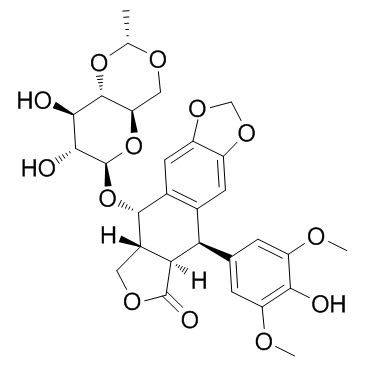Etoposide

Etoposide structure
|
Common Name | Etoposide | ||
|---|---|---|---|---|
| CAS Number | 33419-42-0 | Molecular Weight | 588.557 | |
| Density | 1.6±0.1 g/cm3 | Boiling Point | 798.1±60.0 °C at 760 mmHg | |
| Molecular Formula | C29H32O13 | Melting Point | 236-251ºC | |
| MSDS | USA | Flash Point | 263.6±26.4 °C | |
| Symbol |


GHS07, GHS08 |
Signal Word | Danger | |
|
TAp73 promotes cell survival upon genotoxic stress by inhibiting p53 activity.
Oncotarget 5(18) , 8107-22, (2014) p53 plays a key role in regulating DNA damage response by suppressing cell cycle progression or inducing apoptosis depending on extent of DNA damage. However, it is not clear why mild genotoxic stress favors growth arrest, whereas excessive lesions signal cel... |
|
|
DNA damage-specific deubiquitination regulates Rad18 functions to suppress mutagenesis.
J. Cell Biol. 206(2) , 183-97, (2014) Deoxyribonucleic acid (DNA) lesions encountered during replication are often bypassed using DNA damage tolerance (DDT) pathways to avoid prolonged fork stalling and allow for completion of DNA replication. Rad18 is a central E3 ubiquitin ligase in DDT, which ... |
|
|
SK053 triggers tumor cells apoptosis by oxidative stress-mediated endoplasmic reticulum stress.
Biochem. Pharmacol. 93(4) , 418-27, (2015) Thioredoxins (Trx) together with thioredoxin reductases (TrxR) participate in the maintenance of protein thiol homeostasis and play cytoprotective roles in tumor cells. Therefore, thioredoxin-thioredoxin reductase system is considered to be a promising therap... |
|
|
ELF-MF attenuates quercetin-induced apoptosis in K562 cells through modulating the expression of Bcl-2 family proteins.
Mol. Cell Biochem. 397(1-2) , 33-43, (2014) This study investigated the effects of sinusoidal ELF-MF (1 mT; 50 Hz) on the apoptosis induced by four different compounds, namely vinblastine, etoposide, quercetin, and resveratrol, in human K562 chronic myeloid leukemia cells. The exposure to ELF-MF did no... |
|
|
High-throughput screening identifies inhibitors of DUX4-induced myoblast toxicity.
Skelet. Muscle 4 , 4, (2014) Facioscapulohumeral muscular dystrophy (FSHD) is caused by epigenetic alterations at the D4Z4 macrosatellite repeat locus on chromosome 4, resulting in inappropriate expression of the DUX4 protein. The DUX4 protein is therefore the primary molecular target fo... |
|
|
Upregulation of Stat1-HDAC4 confers resistance to etoposide through enhanced multidrug resistance 1 expression in human A549 lung cancer cells.
Mol. Med. Report. 11(3) , 2315-21, (2014) Despite efforts to develop efficient chemotherapeutic drug strategies to treat cancer, acquired drug resistance is a commonly encountered problem. In the present study, to investigate this phenomenon, human A549 lung cancer cells resistant to the topoisomeras... |
|
|
Proteomic analysis reveals novel common genes modulated in both replicative and stress-induced senescence.
J. Proteomics 128 , 18-29, (2015) Cellular senescence causes profound changes in gene expression profile. In this study, we used a combined 2D-DIGE and nanoLC-ESI-LIT-MS/MS approach to evaluate the proteomic changes occurring both in replicative and stress-induced senescence of human IMR90 ce... |
|
|
Etoposide induces cell death via mitochondrial-dependent actions of p53.
Cancer Cell Int. 15 , 79, (2015) Etoposide has been used clinically in cancer treatment, as well as in numerous research studies, for many years. However, there is incomplete information about its exact mechanism of action in induction of cell death.Etoposide was compared at various concentr... |
|
|
Targeting the gyrase of Plasmodium falciparum with topoisomerase poisons.
Biochem. Pharmacol. 95 , 227-37, (2015) Drug-resistant malaria poses a major public health problem throughout the world and the need for new antimalarial drugs is growing. The apicoplast, a chloroplast-like organelle essential for malaria parasite survival and with no counterpart in humans, offers ... |
|
|
Tumor Repression of VCaP Xenografts by a Pyrrole-Imidazole Polyamide.
PLoS ONE 10 , e0143161, (2015) Pyrrole-imidazole (Py-Im) polyamides are high affinity DNA-binding small molecules that can inhibit protein-DNA interactions. In VCaP cells, a human prostate cancer cell line overexpressing both AR and the TMPRSS2-ERG gene fusion, an androgen response element... |